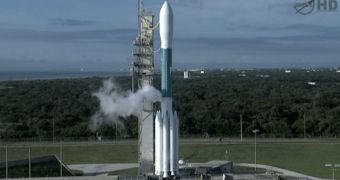The American space agency should have launched the Gravity Recovery and Interior Laboratory (GRAIL) mission by now, but a set of unfortunate circumstances have delayed the attempt until Saturday, September 10, at the earliest.
Originally, the two spacecraft making up this mission were supposed to take off on Thursday, September 8, but rough winds high above the launch pad forced NASA officials to scrub the attempt, and reset for another try to take place today.
While the fuel was being drained from the delivery system that carries GRAIL, experts observed what may be a potential glitch, so another 24-hour delay was enforced. Engineering teams will need at least today to fix the issues they find, if any.
A statement from NASA says that the launch team will resume preparations as soon as the delivery system is fixed and checked. The agency has until mid-October at its disposal to launch the mission, which is bound to reach the Moon by New Year's Eve.
For this Saturday, mission controllers have two available launch windows, which open at 8:29 am EDT and 9:08 am EDT(1229 GMT and 1308 GMT), respectively. For every day of delay, these opportunities move a few minutes earlier in the morning than the day before.
GRAIL will take off from the Cape Canaveral Air Force Station's (CCAFS) Space Launch Complex 17B (SLC-17B), aboard a Delta II 7920H-10 delivery system. The spacecraft are scheduled to begin their science mission in March 2012, but the date depends on the success of the testing phase.
Both probes will take about three-and-a-half months to reach their destination, as they will be traveling through the Sun-Earth Lagrange Point 1 rather than a direct lunar-injection orbit. This option was selected because of the massive fuel savings it makes possible.
As soon as its primary mission starts, scientists will be able to answer fundamental questions about the Moon’s composition, internal structure and evolution. Our planet's evolution, and the early history of the solar system implicitly, will also become clearer.
For tomorrow, weather experts at the CCAFS predict a 60 percent chance of favorable conditions. Officials are hoping for a break in the wind, so that they have just sufficient time to launch GRAIL before the weather gets worse again, Space reports.
Maria Zuber, the Earle A. Griswold Professor of Geophysics and Planetary Science at MIT, is the principal investigator for the mission. GRAIL will be managed by experts at the NASA Jet Propulsion Laboratory (JPL), in Pasadena, California.

 14 DAY TRIAL //
14 DAY TRIAL //